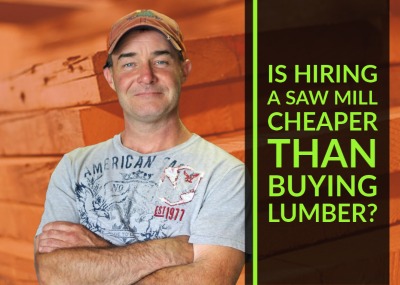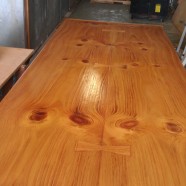UPDATED FOR 2021
The number one question landowners ask us: Is it cheaper to have lumber milled from your own property or buy it from a big box store?
When this article was originally written, there was no pandemic and life was….well, normal! Covid changed supply and demand for more than just toilet paper (which ironically is also made from….trees…hmmm…). It drastically affected lumber prices as well. According to a recent article penned by Sandy Griffis, Executive Director for the Arizona’s Yavapai County Contractors Association:
“Soaring lumber prices that have tripled over the past 12 months have caused the price of an average new single-family home to increase by $35,872 and up, according to the National Association of Homebuilders. The average price this past week for a framing lumber package was $1,446 per thousand board feet. One year ago the price was $441 per thousand board feet.”
This sharp increase for the big boys brings new opportunities for smaller mills like ours to be competitive while providing the landowner huge savings. A few years ago, the main benefits were getting specialty lumber and other perks (see the Pros listed below). At that time to mill your own cost slightly more depending on the materials you wanted milled (ie 2 x 4’s are cheaper to buy but oak posts and boards were cheaper to mill and have processed). That’s changed.
Now, and apparently through 2022, milling lumber off your property is comparable if not considerably cheaper than buying various building materials. For instance, the price of a 11 1/2″ x 48″ white oak stair tread at the time of this article is $79 each at Lowe’s. From a 13 foot white oak log, Chris can mill approximately 3 stair treads per pass of his sawmill blade. Each pass takes around 10 minutes (after setup and squaring the log) so that translates into $237 worth of stair treads being milled every 10 minutes.
With three passes of the saw mill (ie 30 minutes), you will have materials equal to what you paid for a full day of milling. That is HUGE savings!
The Pros
You Can Get Custom Dimensions and Species
There are some dimensions and types of lumber not available at big stores. For instance, you won’t find 12 foot long cedar beams at Lowes or Home Depot. However, we can mill that if you happen to have a cedar tree at least twelve foot tall and 12 inches in diameter. Another cut that is not found in retail stores is the thicker and wider cut lumber. Thick, farmhouse tables made from one or two solid slabs of wood are in vogue right now. The big box stores don’t carry 3-inch thick, 32 inch wide oak boards.
You Get True Dimensional Lumber
The dimensional lumber at the retailers aren’t true dimensions. This means, that 2 x 4 may have been 2 inches thick and 4 inches wide before it was processed. However, after the planing and drying process, it’s actually only 1.5″ x 3.5″. This fact is especially important if you are renovating an old structure that didn’t use today’s traditional pressure treated wall studs. We mill your logs so that after processing, you have true 2 x 4’s.
Your Wife Will Cry (with Joy)
Although it’s the husband that usually calls us, it’s the wife that gives the final approval. There have been several times we have been on-site milling lumber and the wife gasps when she sees the wood color and grain. We’ve had more than one break down in tears sharing how her Dad was a woodworker or builder and she can’t wait to have her husband build something from that wood. See, hubby – we just reminded her of your hero status : )
And let’s be real. The only time people cry at Lowe’s is when they have to shop there at Christmas time.
You Can Get Live Edge Lumber
Live edge lumber is when one or both sides of lumber is left in its natural state vs having it squared off like with dimensional lumber. You can’t buy live edge lumber at retailers. Hiring a saw mill allows you to have Carolina Siding, which is live edge on one side. You can also have live edge on both sides for projects like countertops, farmhouse tables and other heirloom furniture.
You Can Get Bookmatched Lumber Sawn
For the non-woodworkers reading this. Bookmatched lumber is lumber that is milled from the same tree sequentially so that when you place two pieces side by side, they mirror each other. It’s like opening a book and seeing the same image identical image on each side. The picture to the right is a photo of a bookmatched pine table Chris made from a tree in his own yard.
You Save on Landfill and Waste Removal Costs
Typically, when you hire a tree company to remove a tree, they remove all of it. If they are hauling the brush off vs chipping it, they’ll charge you for the landfill costs. They will take the longer, straight sections of trunk and sell them to a wholesale lumber distributor that deals with loggers. So, they are not only making money on the front end by charging you to remove the tree, they are also making money by selling your tree to another outfit. Rather than pay them to make money off your tree (that you already paid them to remove), why not treecycle it into lumber that you can use or sell later?
You Don’t Have to Drive to Pick Your Lumber Up
Because we mill on your site, you don’t have the inconvenience of driving to the store, shopping for lumber, loading that lumber then unloading that lumber at your house. While we mill, we stack your lumber for maximum airflow so that all you have to do is admire your stacks of wood.
You Save the Environment
Landfills are growing more everyday. It just feels better to reuse rather than toss perfectly good wood in the world’s trash bin.

Cedar Adirondack Bench with Tree Frog Cut Out. Chris built this for his mom from trees off his family’s property. Yes, she cried.
You AND Your Kids Get Bragging Rights
When you build a house, a building or a piece of furniture using wood milled off your property, you have not only a physical object to pass down, you have something timeless-a story behind it. Imagine telling your kids how the floors in your house came from that oak tree that you and their uncle used as first base when YOU were kids. Or how that dining room table they eat at every night used to be a cedar tree that you and their grandfather planted before they were born. Priceless.
The Cons
Pre-Planning
To get the most from your tree, it’s best to know what you want to use it for once it’s milled. This requires you figure out how many board feet of lumber you need and what dimensions you need them milled into. Actually, this isn’t a con if you consider that any project will require a materials list.
It Takes Longer to Use Your Lumber
Depending on the type of tree and project you want to use it for, you may need to kiln dry your lumber. This will require factoring in air drying and kiln drying time. If you want to use your lumber to build your house, you will need to coordinate timing with your general contractor. Typically, you will want to have your trees milled at least six months prior to when your builder is constructing your home. Lumber purchased at a retailer is ready to use so no need to plan six months in advance.
It May Cost More
Depending on the type of lumber you want milled, it may be cheaper to purchase your wood from a retailer. One example would be 2 x 4s. It is cheaper to buy those at the big stores. This is due to the fact that the more passes the mill makes on a log, the longer it takes. In other words, if you have a 12″ diameter log and you have it milled into 1″ thick boards, the mill must make 12 passes. Where as, if you wanted 2″ thick boards, it would take only 6 passes. We simply can’t compete on price against high-volume mills that cut those dimensions.
The true value in using a saw mill is for the specialty woods and cuts available on your property but not in the store (like that 12 foot long cedar beam). This is also true of the more expensive woods that can be found on people’s property, like oak. For instance, ONE 1″x8″x8′ red oak board from Lowes is around $50 (at the time of this article). In this case, we CAN compete by giving you more boards for less money.
Conclusion
In the end, only you can decide if milling lumber from your own property is worth it. Because every job is different, we can not tell you the actual amount of money you would save or not save. Generally, it costs 5-10% more to have your lumber milled on-site. It is also cheaper to by 2 x 4’s from a big box store than it is to have them milled. So if you are more concerned with quantity over quality, saw milling may not be for you.
That said, if the dimensions and species you want are unavailable at retailers or if conservation and sentimental reasons are your motivation, then a saw mill is definitely the best choice.


